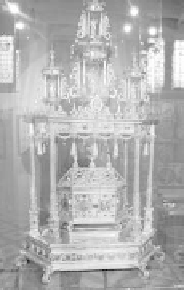Travel Reference
In-Depth Information
Friday—and increasingly on other days, too—the tabernacle's
doors will be open, so you can actually see the vial of blood.) On
holy days, the relic is shifted across the room and displayed on the
throne under the canopy.
Treasury
(next to Upper Chapel): For €1.50, you can see the
impressive gold-and-silver, gem-studded, hexagonal reliquary
(c. 1600, left wall) that the vial of blood is
paraded around in on feast days. The vial
is placed in the “casket” at the bottom
of the four-foot-tall structure. On the
wall, f lanking the shrine, are paintings
of kneeling residents who, for centuries,
have tended the shrine and organized
the pageantry as part of the 31-mem-
ber Brotherhood of the Holy Blood.
Elsewhere in the room are the Brothers'
ceremonial necklaces, clothes, chalices,
and so on.
In the display case by the entrance,
find the lead box that protected the vial of blood from Protestant
extremists (1578) and French Revolutionaries (1797) bent on
destroying what, to them, was a glaring symbol of Catholic mumbo-
jumbo. The broken rock-crystal tube with gold caps on either end
is a replica of the vial, giving an idea of what the actual relic looks
like. Opposite the reliquary are the original cartoons (from 1541)
that provided the designs for the basilica's stained glass.
City Hall (stadhuis)
Built in about 1400, when Bruges was a thriving bastion of capital-
ism with a population of 35,000, this building served as a model
for town halls elsewhere, including Brussels. The white sand-
stone facade is studded with statues
of knights, nobles, and saints with
prickly Gothic steeples over their
heads. A colorful double band of cities'
coats of arms includes those of Bruges
(Brugghe) and Dunkirk (Dunquerke).
Back then, Bruges' jurisdiction
included many towns in present-day
France. The building is still the City
Hall, and it's not unusual to see cou-
ples arriving here to get married.
Entrance Hall:
The ground-level lobby (free, closed Mon)
leads to a picture gallery with scenes from Belgium's history, from
the Spanish king to the arrival of Napoleon, shown meeting the
mayor here at the City Hall in 1803.






















